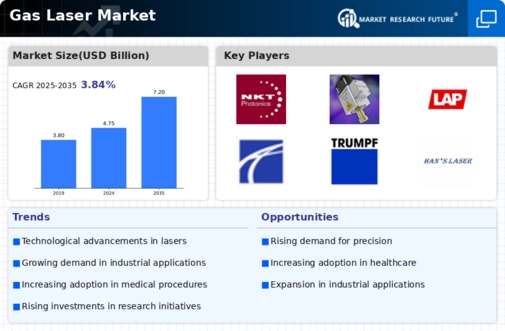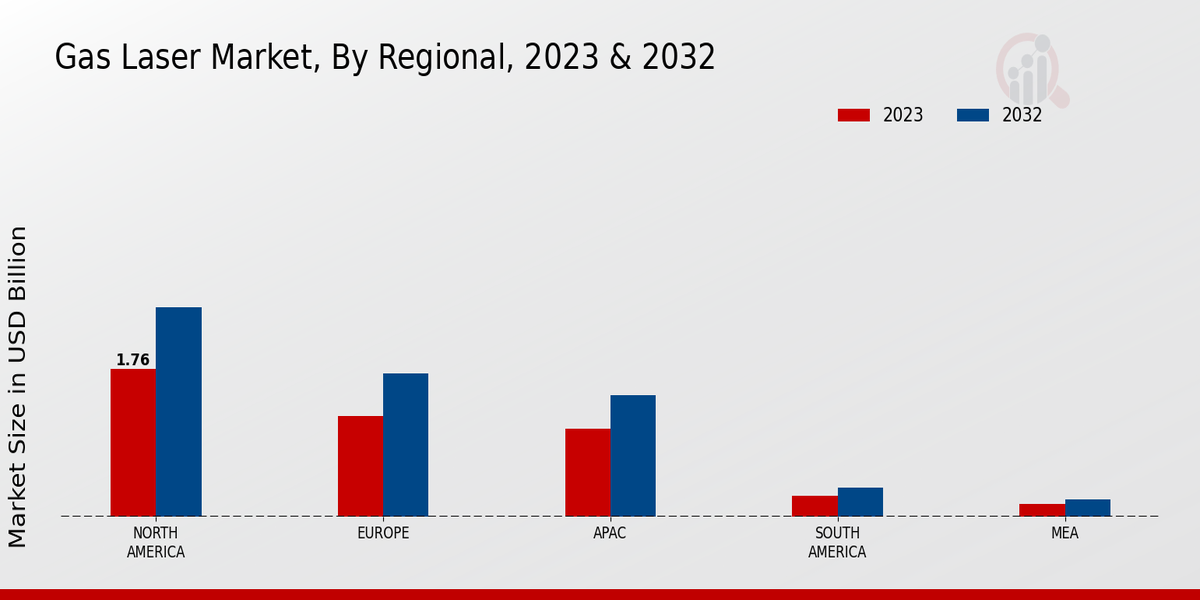Technological Advancements
The Global Gas Laser Market Industry is experiencing a surge in technological advancements, which are enhancing the efficiency and performance of gas lasers. Innovations in laser design, such as the development of high-power gas lasers and improved gas mixtures, are driving market growth. These advancements enable applications in various sectors, including manufacturing, telecommunications, and medical fields. For instance, the introduction of carbon dioxide lasers has revolutionized cutting and welding processes, leading to increased productivity. As a result, the market is projected to reach 4.75 USD Billion in 2024, with a compound annual growth rate of 3.85% anticipated from 2025 to 2035.
Market Trends and Projections
Rising Adoption in Medical Applications
The Global Gas Laser Market Industry is experiencing an uptick in the adoption of gas lasers within the medical field, particularly in surgical and therapeutic applications. Gas lasers, such as argon and carbon dioxide lasers, are utilized for precise surgical procedures, including dermatological treatments and ophthalmic surgeries. The effectiveness of these lasers in minimizing tissue damage and promoting faster recovery times is driving their popularity among healthcare providers. As the healthcare sector continues to innovate and expand, the demand for gas lasers is likely to grow, contributing to the overall market growth and enhancing its value in the medical industry.
Growing Demand in Industrial Applications
The Global Gas Laser Market Industry is witnessing a growing demand for gas lasers in industrial applications, particularly in cutting, welding, and engraving processes. Industries such as automotive, aerospace, and electronics are increasingly adopting gas lasers due to their precision and efficiency. For example, the use of nitrogen lasers in the automotive sector for cutting metal components has proven to enhance production speed and reduce waste. This trend is expected to contribute to the market's expansion, with projections indicating a growth to 7.2 USD Billion by 2035. The increasing need for automation and high-quality manufacturing processes further supports this demand.
Environmental Regulations and Sustainability
The Global Gas Laser Market Industry is influenced by stringent environmental regulations and a growing emphasis on sustainability. As industries strive to reduce their carbon footprint, gas lasers are increasingly favored for their energy efficiency and lower emissions compared to traditional laser technologies. For example, the adoption of eco-friendly gas mixtures in laser systems aligns with regulatory requirements and sustainability goals. This shift towards greener technologies is likely to bolster the demand for gas lasers, as companies seek to comply with environmental standards while maintaining operational efficiency. Such trends indicate a positive outlook for the market.
Increased Investment in Research and Development
The Global Gas Laser Market Industry is benefiting from increased investment in research and development activities aimed at enhancing laser technologies. Governments and private entities are allocating funds to explore new gas laser applications and improve existing technologies. This investment is fostering innovation, leading to the development of more efficient and versatile gas lasers. For instance, research initiatives focused on optimizing gas mixtures and laser configurations are yielding promising results. Such advancements not only enhance the performance of gas lasers but also open new avenues for their application across various sectors, thereby driving market growth.












